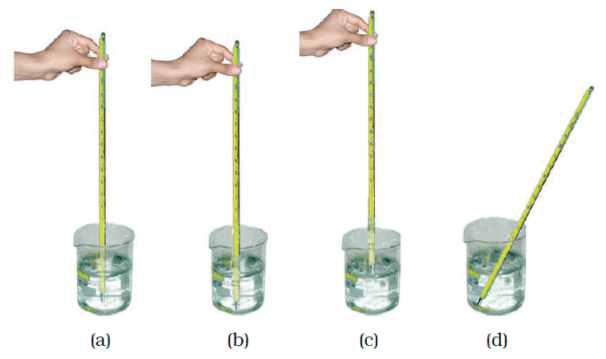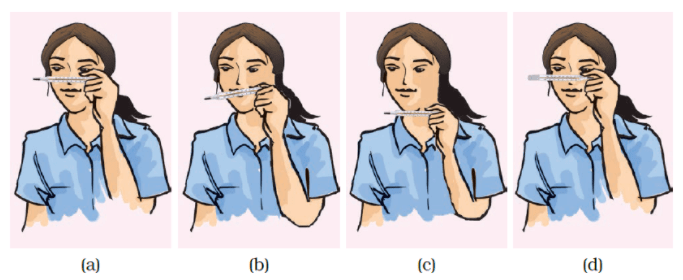NCERT Exemplar Solutions: Heat | Science Class 7 (Old NCERT) PDF Download
Multiple Choice Questions
Q.1. A marble tile would feel cold as compared to a wooden tile on a winter morning because the marble tile
(a) is a better conductor of heat than the wooden tile.
(b) is polished while the wooden tile is not polished.
(c) reflects more heat than wooden tile.
(d) is a poor conductor of heat than the wooden tile.
Ans: a
- The marble tile feels colder because it conducts heat better than the wooden tile.
- Heat from your body is transferred to the marble more quickly.
- This makes the marble feel colder to the touch compared to wood.
Q.2. A beggar wrapped himself with a few layers of newspaper on a cold winter night. This helped him to keep himself warm because
(a) friction between the layers of newspaper produces heat.
(b) air trapped between the layers of newspaper is a bad conductor of heat.
(c) newspaper is a conductor of heat.
(d) newspaper is at a higher temperature than the temperature of the surrounding.
Ans: b
- The air trapped between the layers of newspaper acts as an insulator.
- This prevents heat from escaping, helping to keep the body warm.
- Thus, the newspaper layers provide effective insulation against the cold.
Q.3. Paheli and Boojho measured their body temperature. Paheli found her’s to be 98.6 °F and Boojho recorded 37°C. Which of the following statement is true?
(a) Paheli has a higher body temperature than Boojho.
(b) Paheli has a lower body temperature than Boojho.
(c) Both have a normal body temperature.
(d) Both are suffering from fever.
Ans: c
Degree Celsius and Fahrenheit are two scales of temperature measurement. Normal body temperature is 37º which is equal to 98.6 F. Hence both of them have normal body temperature.
Q.4. Boojho has three thermometers as shown in Figure. He wants to measure the temperature of his body and that of boiling water. Which thermometer (s) should he choose?

(a) Thermometer (i) or (iii) for measuring body temperature and (ii) for measuring the temperature of boiling water.
(b) Thermometer (i) for measuring the temperature of both.
(c) Thermometer (ii) for measuring the temperature of both.
(d) Thermometer (iii) for measuring the temperature of both.
Ans: a
Image 1 and 3 are of clinical thermometer use to measure body temperature and image 2 is of laboratory thermometer which is used to measure room temperature.
Q.5. Four arrangements to measure the temperature of the ice in a beaker with laboratory thermometer are shown in Figure (a, b, c and d). Which one of them shows the correct arrangement for accurate measurement of temperature?

Ans: a
Q.6. Figure (a–d) shows a student reading a doctor’s thermometer. Which of the figure indicates the correct method of reading temperature?
Ans: a
Q.7. Figure 4.4. (a–d) shows the readings on four different thermometers. Indicate which of the reading shows the normal human body temperature?

Ans: c
Image c shows reading 37º c which is human’s body temperature hence answer is c)
Very Short Answer Questions
Q.1. Shopkeepers selling ice blocks usually cover them with jute sacks. Explain why.
Ans: Shopkeepers selling ice blocks cover them with jute sacks for several reasons:
- Insulation: Jute sacks, along with materials like sawdust and newspapers, act as insulators.
- Heat Prevention: These materials help to prevent heat from escaping or entering, keeping the ice blocks colder for longer.
Q.2. A laboratory thermometer A is kept 7 cm away on the side of the flame while a similar thermometer B is kept 7 cm above the flame of a candle as shown in Figure.

Which of the thermometers, A or B, will show a greater rise in temperature? Give a reason for your answer.
Ans: The answer is image b) because hot air rises up from candle which burns due to convection.
- Hot air rises due to convection.
- As the candle burns, it heats the air above it.
- Thermometer B, being above the flame, is directly in the path of the rising hot air.
- In contrast, thermometer A is less affected by the heat.
Q.3. To keep her soup warm Paheli wrapped the container in which it was kept with a woollen cloth. Can she apply the same method to keep a glass of cold drink cool? Give a reason for your answer
Ans: Yes, a woollen cloth can be used to keep a glass of cold drink cool. Here’s why:
- Wool is an insulator, which means it does not conduct heat well.
- This property helps to prevent heat transfer from the surroundings to the cold drink.
- As a result, the cold drink stays cooler for a longer time.
Q.4. In a mercury thermometer, the level of mercury rises when its bulb comes in contact with a hot object. What is the reason for this rise in the level of mercury?
Ans: Mercury expands when heated, causing its level to rise in the capillary tube of the thermometer.
- When the bulb contacts a hot object, the mercury heats up.
- As the temperature increases, the mercury expands.
- This expansion pushes the mercury higher in the tube.
Short Answer Questions
Q.1. A circular metal loop is heated at point O as shown in Figure.

(i) In which direction would heat flow in the loop?
(ii) In which order the pins at points P,Q and R fixed with the help of wax fall if points O, P, Q and R are equidistant from each other?
Ans: The heat will flow in both the directions i.e. from O to P and O to R.
At first, the pins at R and P will fall simultaneously followed by the pin at Q.
Q.2. In the arrangements, A and B shown in Figure, pins P and Q are fixed to a metal loop and an iron rod with the help of wax. In which case are both the pins likely to fall at different times? Explain.

Ans:
In case ‘B’ the pin P will fall before the pin Q because the heat will reach pin P first. In case ‘A’, the heat travels in both the directions and pins P and Q will fall simultaneously.
Q.3. For setting curd, a small amount of curd is added to warm milk. The microbes present in the curd help in setting if the temperature of the mixture remains approximately between 35°C to 40°C. At places, where room temperature remains much below the range, the setting of curd becomes difficult. Suggest a way to set curd in such a situation.
Ans: In order to maintain the desired temperature container with curd should be wrapped with woollen or any other insulator. Curd can also be set in a room with temperature below optimum by keeping the container near the gas stove.
Q.4. You may have noticed that a few sharp jerks are given to clinical thermometer before using it. Why is it done so?
Ans: The sharp jerks given to a clinical thermometer serve an important purpose:
- The jerks help to move the mercury back into the bulb.
- This action ensures that the mercury level is below normal temperature before use.
- As a result, the thermometer can accurately measure the body's temperature.
Q.5. Why is it advised not to hold the thermometer by its bulb while reading it?
Ans: If we hold the thermometer by its bulb while reading it, the mercury will get expanded by our body temperature.
Q.6. At a campsite, there are tents of two shades – one made with black fabric and the other with white fabric. Which one will you prefer for resting on a hot summer afternoon? Give a reason for your choice. Would you like to prefer the same tent during winter?
Ans: In summer I would choose a tent with white colour fabric as white is a bad absorber and a good reflector of Heat. But in winter I would choose a tent with black colour fabric as black is a good absorber and bad reflector of heat.
Q.7. While constructing a house in a coastal area, in which direction should the windows preferably face and why?
Ans: The windows of houses in coastal areas should preferably face towards the sea as sea breeze will keep it cool during day time.
Q.8. Observe the picture given in Figure. Water is being boiled in a pan of wide base.

Which position P or T will feel warmer?
Fill up the boxes P and T to indicate the mode of flow of heat to the hand.
Ans: Position ‘P’ will feel warmer due to rising up of hot air.
P Convection
T Radiation
Q.9. Look at Figure.

The length of wire PQ in case of A is equal to the diameter of the semicircle formed by the wire CDE, in case B. One pin is attached to each wire with the help of wax as shown in Figure. Which pin will fall first? Explain.
Ans: The pin on the wire in case A will fall first as heat will react to it before it reaches the pin in case B.
|
111 videos|435 docs|28 tests
|
FAQs on NCERT Exemplar Solutions: Heat - Science Class 7 (Old NCERT)
| 1. What is the concept of heat in Class 7 Science? |  |
| 2. How is heat measured? |  |
| 3. What are the three methods of heat transfer? |  |
| 4. How does insulation work to reduce heat transfer? |  |
| 5. Give an example of conduction, convection, and radiation in daily life. |  |

















